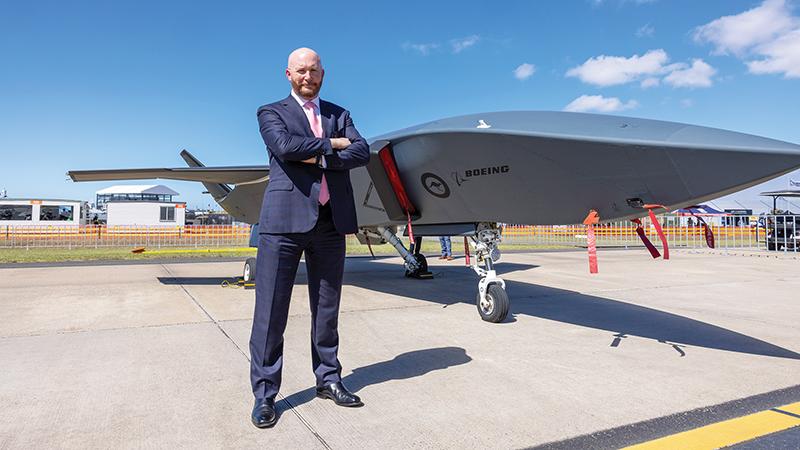Top Exec Steve Parker Previews F-47-Based Turnaround At Boeing Defense
Details
More Products & Services
Products & Services
Home - Aviation Group Marketing
Aviation Week Network
120 data points on over 156,000 commercial and business aviation aircraft, including military transports. Discover the most trustworthy resource for the complete aircraft history, plus ad hoc reports, month-over-month trend analysis and details on expected deliveries through 2050.
Aerospace | Aviation Week Network
Aviation Week Network
https://aviationweek.com/themes/custom/particle/dist/app-drupal/assets/awn-logo.svg
People

Andrea Rossi Prudente
Aviation Week Network

Anthony Lim
Aviation Week Network
Sales director

Becca Balmes
Aviation Week Network

Belinda Tan
Aviation Week Network

Brian Everstine
Aviation Week Network
Editor

Eddie Krankowski
Aviation Week Network
Assistant Manager, Tradeshows

erving dockery
Aviation Week Network

Lisa Tan
Aviation Week Network
Senior Marketing Manager

Mark Thomas
Aviation Week Network
Description
The call came in to St. Louis at 9:34 a.m. CDT on March 21. President Donald Trump was scheduled to announce at 11 a.m. EDT the winner of the U.S. Air Force contract to develop what would soon become known as the F-47, the first U.S.-built sixth-generation fighter.
Both contenders—Boeing Defense and Space (BDS) and Lockheed Martin Aeronautics—knew the rules. A half-hour before the announcement, the Air Force would inform the leaders of both companies privately. The lucky winner would receive the first call at 10:30 EDT sharp. The second call would then be to the loser.
Inside a secure, classified facility on Boeing's St. Louis campus, the anxiety rose as each minute past 9:30 CDT ticked by. Seeking to make a dramatic turnaround by winning a flagship defense program, Boeing had invested billions of dollars in infrastructure, committed a decade's worth of engineering work and abandoned once-promising market sectors in a make-or-break gamble to win the right to deliver the F-47.
Finally, the call came—4 min. late. Surrounded by a crowd of anxious employees, Steve Parker, the BDS interim CEO, answered the phone and heard the news: Boeing had won.
“It'll be the most memorable thing I've ever done in my career—just to tell the team and to feel the shock wave of emotion that came back,” Parker told Aviation Week two months later. He recalled how that visceral response from the employees physically knocked him backward.
“I was completely shocked,” Parker said. “You've got people blubbering, and grown men and women just absolutely crying because they had put in everything that they've got. There are these things in the aviation [industry]—I don't think the general public understands the stakes.”
The Air Force now plans to spend at least $20 billion to complete development of the F-47, aiming to field the most advanced fighter in the world within several years. In a single stroke, the contract vaults BDS over rival Lockheed, whose stealthy and sensor-fused F-22 and F-35 defined the fifth-generation fighter standard for aerial warfare technology.
For BDS, the industrial victory was sorely needed. A string of contract wins for trainers, uncrewed aerial tankers and the next presidential transport in 2018 and 2019 refilled the division's order backlog as decades-old F/A-18E/F and F-15EX assembly lines faced an uncertain future.
But the MQ-25, T-7A and VC-25B—in combination with the Air Force's KC-46 tanker and NASA's Starliner spacecraft—had saddled BDS with thorny technical problems and money-losing, fixed-price development deals, resulting in reach-forward losses totaling more than $18 billion since 2014.
As Boeing ramps up development activity on the F-47, Parker is not yet willing to declare victory over the issues that have plagued execution on the fixed-price programs. In the first quarter, BDS reported no reach-forward losses for the first time in three years, but because of delays, all five programs are still 1-3 years away from completing development. The risk of surprises in flight testing remains.
The first quarter was “a great start, but, you know, it's one quarter,” Parker said. “Looking at this from a long-term view, we're going to have discovery from time to time.”
Boeing's victory has created another challenge. A new Advanced Combat Aircraft Facility (ACAF) is rising on the southwest corner of Boeing's fighter production complex in St. Louis. Hundreds of personnel will soon fill the ACAF to start building the first F-47s and perhaps the U.S. Navy F/A-XX, the F/A-18E/F replacement Boeing is competing against Northrop Grumman to build. Somehow, Boeing must ramp up staffing at the ACAF while keeping a large portfolio of other military aircraft projects on track.
In addition to the fixed-price development programs, Boeing is also slowly building up production on the F-15EX and upgrading the engine, cockpit and radar on the B-52 bomber. The latter recently suffered a cost overrun that triggered a Nunn-McCurdy review.
At the moment, Parker says he has no concerns about staffing. The St. Louis site has been at peak personnel levels in the engineering department for several years, as Boeing delivered the F/A-18E/F Block III upgrade, EA-18G Block II upgrade, F-15EX, F-15QA and T-7 at the same time. Resignations and attrition in the BDS engineering department are running at industry-leading low levels, Parker noted.
“Staffing is not going to be an issue,” he asserted. “We're going to be staffed all the way through this to make sure we can deliver on the promises that we've made.”
Parker's use of the past tense to describe fulfilling promises made by Boeing is part of that strategy. To focus resources on existing commitments, BDS plans to be more selective about when and how to take on new minor projects, even if it has to disappoint some customers demanding small upgrades.
“It will force me into a situation where [I focus on] what's really the priority,” Parker said. “There are things that I could be doing for customers that will not be the priority. The priority will be these critical programs. So for some minor upgrade, I may choose not to staff that up, and that may go [outside Boeing].”
Those kinds of pressures are part of a wider trend in the defense market. As traditional prime contractors focus on core businesses, smaller defense enterprises, nontraditional companies and startups are looking for opportunities in similar roles. Even if many of these smaller companies are not ready to deliver an aircraft as advanced as the F-47, they are increasingly finding opportunities to be prime contractors at lower levels of technology, especially for satellites, Collaborative Combat Aircraft and munitions.
BDS should learn how to partner with those companies, even if it requires working as a subcontractor to a startup, Parker said. The concept involves finding areas where a nontraditional player can contribute a new technology but still lacks the infrastructure for engineering and manufacturing to scale it up into an operational product.
“I'm very open to working with the nontraditionals,” Parker said. “Whether Boeing takes some of its secret sauce—its technology, its ability to scale up or [software] its algorithms—and actually works with the nontraditional, where the nontraditional is the prime and BDS becomes a part of their solution, these are all options we're exploring.”
An example of such a partnership might already be in the works behind the scenes. “There's nothing for me to unpack for you all today, but maybe in the future, you'll see some movement there,” Parker said. “You'll see some things coming up in the coming months.”
At the same time, BDS' strategy will be to avoid getting too far ahead of customer demand on some technologies. That is a lesson from painful experiences in Boeing's recent history. It was only 20 years ago that Boeing was considered a global leader in hypersonic vehicles and strategic missile defense.
In this century's first decade, Boeing designed and flew the scramjet-powered X-43A and X-51A experimental aircraft and deployed the Ground-Based Interceptor. But the company now has no role in the Air Force's Hypersonic Attack Cruise Missile or the Missile Defense Agency's Next-Generation Interceptor or Glide Phase Interceptor.
“I think hypersonics is a really good almost case study in terms of ‘We were there and we were ahead,'” Parker said. “But the market wasn't there. [So] we moved and pivoted elsewhere.”
That internal pivot away from hypersonics and missile defense a decade ago proved significant. Although Boeing lost its position in two promising areas, a behind-the-scenes shift took place, providing more financial and engineering resources to compete in other high-growth areas, Parker explained. In other words, giving up on those technologies made it possible for BDS to prepare to win the F-47 contract and classified work in the military space domain.
“In the national security space environment, I believe we're the market leader,” Parker said. “In the fixed-wing fighter world, . . . we have a transformative capability. Those things just don't happen overnight. They take a great deal of investment, materials and technologies and so forth, and that's what we've done.”
Now, Boeing needs to deliver on that transformative fixed-wing capability. Throughout the largely secret competition with Lockheed, Boeing executives emphasized that the Next-Generation Air Dominance (NGAD) program will be different, setting a new tone for a company that wants finally to shed the cost overruns, schedule delays and bungled execution.
An essential part of Boeing's recovery strategy is to align contracts between the prime and the supply chain. In a major defense program, the financial terms of the government deal—whether fixed-price, cost-plus or a hybrid—apply only to the prime contractor, which must then negotiate separate deals within the supply chain. If not carefully managed, the arrangement on fixed-price deals can force such prime contractors as Boeing to absorb the losses of suppliers.
“Sometimes suppliers are not on a fixed-price contract [with us], or we've got some type of not-to-exceed [deal] in which they might exceed,” Parker said. “So it's really aligning much more tightly at the offer stage.”Hypersonics market exit freed up resources for NGAD bidBoeing aims to align contracts between government program managers and suppliers
Another new feature of the F-47 program is the government management structure. When the Air Force Materiel Command established the Agile Development Office to manage the NGAD program, it set out to follow the example of the Rapid Capabilities Office (RCO), which is responsible for fielding the Boeing X-37 and Northrop B-21 Raider.
“It's very similar to the mindset we have right now in terms of getting risk out of the system early, getting discovery done early and in a much more collaborative, cooperative fashion,” Parker said.
“But when it comes to the F-47,” he explained, “I'll decline to say too much more there, other than it's really the relationship between the customer and in this case, the post-award Boeing to define risks, to put the right milestones in place, to make sure you have the right elements of schedule margin and technical margin.”
Boeing has one advantage on the F-47 program with discovering problems early. In March, DARPA confirmed for the first time that the initial flight of Boeing's secret NGAD demonstrator occurred in 2019. That gives Boeing about six years of hands-on experience with a flying example of the advanced technologies now entering development.
In the competition that led to the F-35 two decades ago, flight demonstrators were available for only a year before full-scale development began. The same timeline applied to the experimental aircraft that informed the selection of the F-22 a decade before.
Asked if the longer lead time for the F-47 demonstrator would pay dividends in the next phase, Parker said: “Absolutely.”
Parker has one more tip for managing the F-47—and, possibly, the future of BDS. “Don't screw it up,” he said. “That's the plan.”
Both contenders—Boeing Defense and Space (BDS) and Lockheed Martin Aeronautics—knew the rules. A half-hour before the announcement, the Air Force would inform the leaders of both companies privately. The lucky winner would receive the first call at 10:30 EDT sharp. The second call would then be to the loser.
Inside a secure, classified facility on Boeing's St. Louis campus, the anxiety rose as each minute past 9:30 CDT ticked by. Seeking to make a dramatic turnaround by winning a flagship defense program, Boeing had invested billions of dollars in infrastructure, committed a decade's worth of engineering work and abandoned once-promising market sectors in a make-or-break gamble to win the right to deliver the F-47.
Finally, the call came—4 min. late. Surrounded by a crowd of anxious employees, Steve Parker, the BDS interim CEO, answered the phone and heard the news: Boeing had won.
“It'll be the most memorable thing I've ever done in my career—just to tell the team and to feel the shock wave of emotion that came back,” Parker told Aviation Week two months later. He recalled how that visceral response from the employees physically knocked him backward.
“I was completely shocked,” Parker said. “You've got people blubbering, and grown men and women just absolutely crying because they had put in everything that they've got. There are these things in the aviation [industry]—I don't think the general public understands the stakes.”
The Air Force now plans to spend at least $20 billion to complete development of the F-47, aiming to field the most advanced fighter in the world within several years. In a single stroke, the contract vaults BDS over rival Lockheed, whose stealthy and sensor-fused F-22 and F-35 defined the fifth-generation fighter standard for aerial warfare technology.
For BDS, the industrial victory was sorely needed. A string of contract wins for trainers, uncrewed aerial tankers and the next presidential transport in 2018 and 2019 refilled the division's order backlog as decades-old F/A-18E/F and F-15EX assembly lines faced an uncertain future.
But the MQ-25, T-7A and VC-25B—in combination with the Air Force's KC-46 tanker and NASA's Starliner spacecraft—had saddled BDS with thorny technical problems and money-losing, fixed-price development deals, resulting in reach-forward losses totaling more than $18 billion since 2014.
As Boeing ramps up development activity on the F-47, Parker is not yet willing to declare victory over the issues that have plagued execution on the fixed-price programs. In the first quarter, BDS reported no reach-forward losses for the first time in three years, but because of delays, all five programs are still 1-3 years away from completing development. The risk of surprises in flight testing remains.
The first quarter was “a great start, but, you know, it's one quarter,” Parker said. “Looking at this from a long-term view, we're going to have discovery from time to time.”
Boeing's victory has created another challenge. A new Advanced Combat Aircraft Facility (ACAF) is rising on the southwest corner of Boeing's fighter production complex in St. Louis. Hundreds of personnel will soon fill the ACAF to start building the first F-47s and perhaps the U.S. Navy F/A-XX, the F/A-18E/F replacement Boeing is competing against Northrop Grumman to build. Somehow, Boeing must ramp up staffing at the ACAF while keeping a large portfolio of other military aircraft projects on track.
In addition to the fixed-price development programs, Boeing is also slowly building up production on the F-15EX and upgrading the engine, cockpit and radar on the B-52 bomber. The latter recently suffered a cost overrun that triggered a Nunn-McCurdy review.
At the moment, Parker says he has no concerns about staffing. The St. Louis site has been at peak personnel levels in the engineering department for several years, as Boeing delivered the F/A-18E/F Block III upgrade, EA-18G Block II upgrade, F-15EX, F-15QA and T-7 at the same time. Resignations and attrition in the BDS engineering department are running at industry-leading low levels, Parker noted.
“Staffing is not going to be an issue,” he asserted. “We're going to be staffed all the way through this to make sure we can deliver on the promises that we've made.”
Parker's use of the past tense to describe fulfilling promises made by Boeing is part of that strategy. To focus resources on existing commitments, BDS plans to be more selective about when and how to take on new minor projects, even if it has to disappoint some customers demanding small upgrades.
“It will force me into a situation where [I focus on] what's really the priority,” Parker said. “There are things that I could be doing for customers that will not be the priority. The priority will be these critical programs. So for some minor upgrade, I may choose not to staff that up, and that may go [outside Boeing].”
Those kinds of pressures are part of a wider trend in the defense market. As traditional prime contractors focus on core businesses, smaller defense enterprises, nontraditional companies and startups are looking for opportunities in similar roles. Even if many of these smaller companies are not ready to deliver an aircraft as advanced as the F-47, they are increasingly finding opportunities to be prime contractors at lower levels of technology, especially for satellites, Collaborative Combat Aircraft and munitions.
BDS should learn how to partner with those companies, even if it requires working as a subcontractor to a startup, Parker said. The concept involves finding areas where a nontraditional player can contribute a new technology but still lacks the infrastructure for engineering and manufacturing to scale it up into an operational product.
“I'm very open to working with the nontraditionals,” Parker said. “Whether Boeing takes some of its secret sauce—its technology, its ability to scale up or [software] its algorithms—and actually works with the nontraditional, where the nontraditional is the prime and BDS becomes a part of their solution, these are all options we're exploring.”
An example of such a partnership might already be in the works behind the scenes. “There's nothing for me to unpack for you all today, but maybe in the future, you'll see some movement there,” Parker said. “You'll see some things coming up in the coming months.”
At the same time, BDS' strategy will be to avoid getting too far ahead of customer demand on some technologies. That is a lesson from painful experiences in Boeing's recent history. It was only 20 years ago that Boeing was considered a global leader in hypersonic vehicles and strategic missile defense.
In this century's first decade, Boeing designed and flew the scramjet-powered X-43A and X-51A experimental aircraft and deployed the Ground-Based Interceptor. But the company now has no role in the Air Force's Hypersonic Attack Cruise Missile or the Missile Defense Agency's Next-Generation Interceptor or Glide Phase Interceptor.
“I think hypersonics is a really good almost case study in terms of ‘We were there and we were ahead,'” Parker said. “But the market wasn't there. [So] we moved and pivoted elsewhere.”
That internal pivot away from hypersonics and missile defense a decade ago proved significant. Although Boeing lost its position in two promising areas, a behind-the-scenes shift took place, providing more financial and engineering resources to compete in other high-growth areas, Parker explained. In other words, giving up on those technologies made it possible for BDS to prepare to win the F-47 contract and classified work in the military space domain.
“In the national security space environment, I believe we're the market leader,” Parker said. “In the fixed-wing fighter world, . . . we have a transformative capability. Those things just don't happen overnight. They take a great deal of investment, materials and technologies and so forth, and that's what we've done.”
Now, Boeing needs to deliver on that transformative fixed-wing capability. Throughout the largely secret competition with Lockheed, Boeing executives emphasized that the Next-Generation Air Dominance (NGAD) program will be different, setting a new tone for a company that wants finally to shed the cost overruns, schedule delays and bungled execution.
An essential part of Boeing's recovery strategy is to align contracts between the prime and the supply chain. In a major defense program, the financial terms of the government deal—whether fixed-price, cost-plus or a hybrid—apply only to the prime contractor, which must then negotiate separate deals within the supply chain. If not carefully managed, the arrangement on fixed-price deals can force such prime contractors as Boeing to absorb the losses of suppliers.
“Sometimes suppliers are not on a fixed-price contract [with us], or we've got some type of not-to-exceed [deal] in which they might exceed,” Parker said. “So it's really aligning much more tightly at the offer stage.”Hypersonics market exit freed up resources for NGAD bidBoeing aims to align contracts between government program managers and suppliers
Another new feature of the F-47 program is the government management structure. When the Air Force Materiel Command established the Agile Development Office to manage the NGAD program, it set out to follow the example of the Rapid Capabilities Office (RCO), which is responsible for fielding the Boeing X-37 and Northrop B-21 Raider.
“It's very similar to the mindset we have right now in terms of getting risk out of the system early, getting discovery done early and in a much more collaborative, cooperative fashion,” Parker said.
“But when it comes to the F-47,” he explained, “I'll decline to say too much more there, other than it's really the relationship between the customer and in this case, the post-award Boeing to define risks, to put the right milestones in place, to make sure you have the right elements of schedule margin and technical margin.”
Boeing has one advantage on the F-47 program with discovering problems early. In March, DARPA confirmed for the first time that the initial flight of Boeing's secret NGAD demonstrator occurred in 2019. That gives Boeing about six years of hands-on experience with a flying example of the advanced technologies now entering development.
In the competition that led to the F-35 two decades ago, flight demonstrators were available for only a year before full-scale development began. The same timeline applied to the experimental aircraft that informed the selection of the F-22 a decade before.
Asked if the longer lead time for the F-47 demonstrator would pay dividends in the next phase, Parker said: “Absolutely.”
Parker has one more tip for managing the F-47—and, possibly, the future of BDS. “Don't screw it up,” he said. “That's the plan.”

Share
Recent Chats
Share via email
Future: handle WhatsApp here
Future: handle LinkedIn here
Future: handle Twitter here
SUBMENU HERE
Share via Chat
Copy Link

